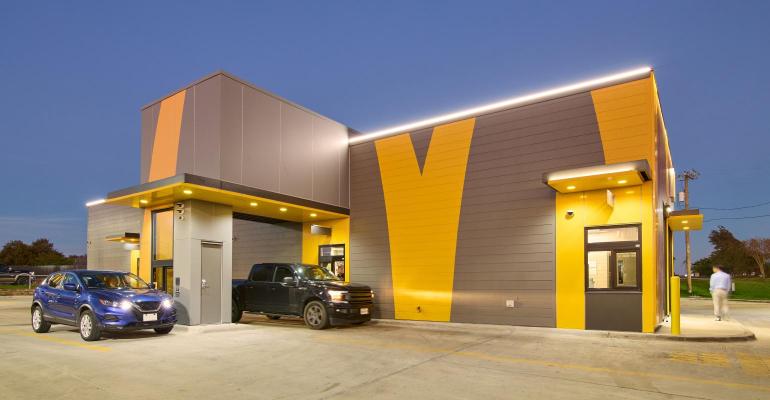McDonald’s has spent the past several years retrenching, closing underperforming restaurants and getting its system in order. Ten years ago, for instance, there were over about 500 more domestic locations than there are now.
But toward the end of last year, McDonald’s U.S. started to grow again. CEO Chris Kempczinski noted during the company’s Q2 earnings call Thursday that it has “earned that right” because of strong cash flow and performance in recent quarters. Restaurant development is so important to the company now, it was added to the Accelerating the Arches 2.0 pillars in January.
Some of this development, however, may look different than it has throughout the company’s nearly-70-year history. To get a better idea of what that means exactly, take a look at the chain’s Fort Worth, Texas, restaurant that opened in 2022. The to-go-only location features a mobile-order-ahead lane, conveyor system that delivers food to customers, self-order kiosks, curbside and an in-restaurant pickup shelf. At nearly 3,200 square feet, it is 26% smaller than an average, traditional McDonald’s.
“The restaurant site is considerably smaller than a traditional restaurant and as the way customers order and receive their food has changed dramatically over the past few years, it is geared toward customers based on their needs wherever they are,” Kempczinski said. “While our primary focus is on opening traditional units, we are always testing and learning new ways to meet the needs of our customers.”
Smaller formats, he added, also open up more real estate opportunities for the company.
“A big reason that we can now look at those is because of the growth that's happened with the digital and delivery, where you don't necessarily need the big dining rooms that you needed in our traditional restaurants. So, you're now able to look at real estate sites that previously would have been sort of off limits to us, those become opportunities,” he added.
McDonald’s is certainly not alone in this quest to meet the changing needs of a changing consumer set. Just this week, for instance, rival Chick-fil-A announced it is testing two digital-forward concepts next year, including one that features four drive-thru lanes and an elevated kitchen above those lanes.
McDonald’s development may also include features pulled from some of its international markets, as per its newly formed Global Business Services unit. Kempczinski pointed to China as an example here, as the market uses food lockers at locations with high in-store traffic, so customers can quickly grab their orders without even entering the restaurant.
Also, GBS is in the process of developing a new concept, called CosMc’s – named after an alien-like McDonaldland character from the 1980s and 90s. Executives didn’t share much detail about CosMc’s other than it will be tested in a “small handful of sites in a limited geography beginning early next year,” and that it is “a small format concept with all the DNA of McDonald’s, but with its own unique personality.”
More information is expected to be shared during McDonald’s Investor Day event later this year.
Something else that may be a bit different about the company’s development plan is the geographic prioritization. Kempczinski noted, for instance, that the U.S. real estate portfolio “reflects probably what the demographic profile of the population profile looked like 20 or 30 years ago.”
“Imagine the amount of shifts that happened – people moving to the South, to the Southeast – that isn’t reflected in our footprint,” he said. “Our footprint reflects what the population probably looked like 20 or 30 years ago, so you end up finding there’s a number of places around the U.S. where we are significantly underdeveloped relative to where the population exists today.
“That opens up a whole bunch of development opportunities for us to go after.”
According to estimates from the U.S. Census Bureau, the South outgrew other U.S. regions last year by 1.3 million people, while the Northeast and Midwest lost residents. According to analysis from 24/7 Wall Street, none of the top 10 states with the most McDonald’s locations are in those states, but are rather Arkansas, West Virginia, Kentucky, Michigan, Ohio, Indiana, Oklahoma, Illinois, Hawaii, and Wisconsin, respectively.
Contact Alicia Kelso at [email protected]





![Smoothie King Ribbon Cutting Terminal A_01[95].jpg](https://www.nrn.com/sites/nrn.com/files/styles/article_related_thumb_standard/public/Smoothie%20King%20Ribbon%20Cutting%20Terminal%20A_0195.jpg?itok=WNYpNsAy)